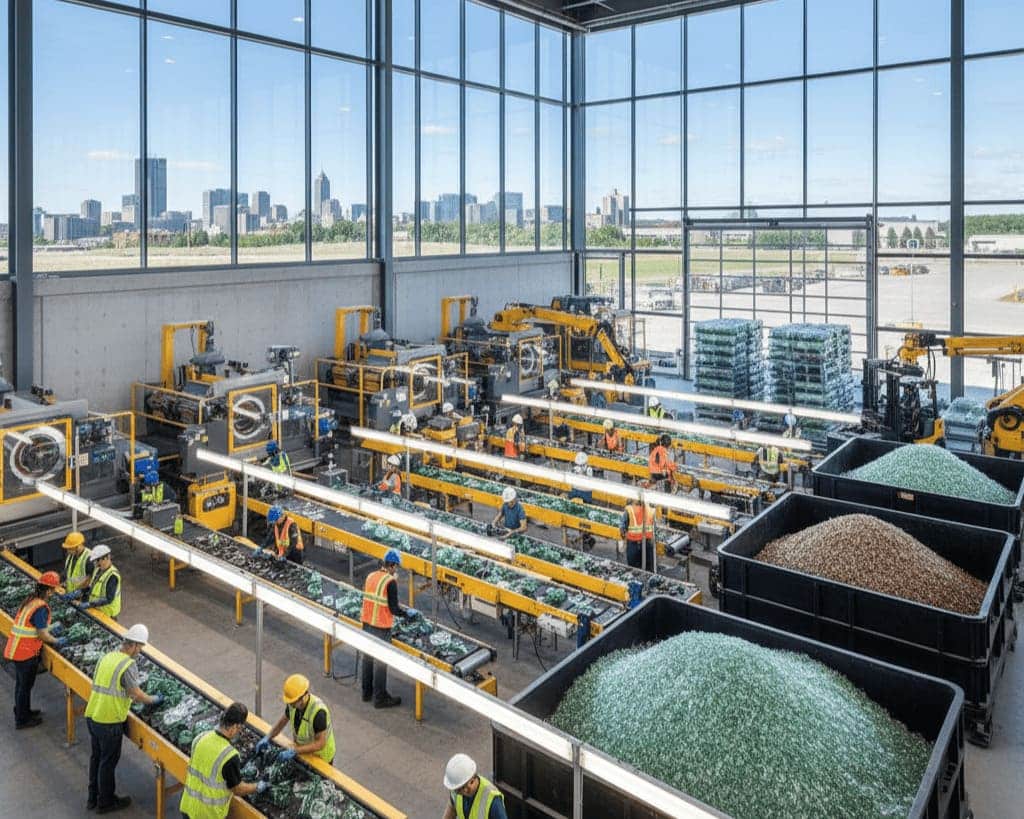Winnipeg’s curbside recycling program is the everyday system that helps homeowners turn paper, containers, and other common household items into new products instead of sending them to a landfill. This guide explains how the program works, what to put in your curbside recycle bins, how glass and specialty items are handled, how the material is sorted, and where to take items that don’t belong in the blue cart. I’ll include local references, real examples, helpful tips for reducing contamination, and how Mr. Garbage can support homeowners with recycling-aware pickup and drop-off options.
What is the curbside recycling program in Winnipeg?
The curbside recycling program is Winnipeg’s municipal collection system for household recyclables. Residents place approved items in their blue curbside recycle bins for scheduled pickup. The city collects paper, cardboard, metal cans, plastic containers, and glass containers through this program and routes them to sorting facilities and processors. The program is designed for routine household volumes and is complemented by the City’s 4R Winnipeg depots for items that are not accepted curbside.
How curbside recycling fits into the broader waste system: curbside collection handles the common everyday streams; depots and special programs handle hazardous materials, bulky glass, electronics, and other items that require different processing. This two-tier approach helps reduce contamination and keeps more material in the recycling stream. City of Winnipeg
How does curbside recycling work in Winnipeg?
Understanding the logistics helps you recycle correctly and avoid rejected loads.
Collection to sorting (the basic flow)
- Place approved recyclables in your blue curbside cart on collection day.
- Automated or manual collection crews pick up the carts and deliver the load to Winnipeg’s material recovery facility or to contracted processors.
- The material is mechanically and manually sorted into paper, cardboard, metals, plastics, and glass containers for baling or direct shipment to end-market processors.
- Non-accepted or hazardous materials are diverted to depot programs for safe handling. City of Winnipeg
Winnipeg has upgraded its sorting technology in recent years to handle single-stream and multi-stream inputs more efficiently. These sorting steps remove contaminants and prepare material for recycling so it can be made into new products.
What can be recycled curbside in Winnipeg?
Knowing what belongs in the curbside recycle bin is the single best way to reduce contamination.
Every day, accepted items.
- Paper and cardboard (flattened and free of food residue).
- Drink and food containers: metal cans, aluminum, plastic bottles, and tubs (rinse and empty).
- Glass bottles and jars — standard containers accepted in most curbside programs.
- Flattened cardboard and paperboard (pizza boxes with heavy grease should be composted or thrown away). City of Winnipeg
Tip: Leave lids on bottles and rinse containers where possible; it reduces odours and keeps the sorting line cleaner. Do not place plastic bags, loose films, or soft plastics in the curbside cart unless the city program explicitly accepts them.
What you need to know about curbside glass recycling
Glass containers are accepted in Winnipeg’s curbside program, but the 4R depots accept a wider variety of glass and special glass items that won’t be collected curbside (for example, certain tempered glass, cookware, or large panes). When in doubt, take special or bulky glass to a 4R depot.
Can you recycle clothes curbside?
Clothing and textiles are not typically accepted in the standard curbside recycling cart. Instead, textiles are best diverted through donation channels or textile collection events and drop-off programs. Many local charities and textile recycling programs accept wearable clothing, shoes, and linens. Donating reusable items keeps them in use and out of the waste stream. If clothing is stained or damaged beyond reuse, some municipal or depot programs accept textiles for recycling; check the City’s depot lists for details.
When did curbside recycling start — a quick historical note
Curbside recycling programs began to roll out across Canadian cities in the late 1980s and 1990s, driven by growing awareness of landfill limits and better markets for recycled materials. Winnipeg’s curbside program grew over time and is now paired with the City’s 4R depots to capture items that don’t travel well in a weekly blue cart. The system continues to evolve as sorting technology and market demand change. For the national context, solid-waste diversion from residential sources has increased significantly over the past decades. Residential diversion has been a major driver of recycled tonnage nationwide. Canada
How is curbside recycling sorted? (from cart to new products)
Sorting is both mechanical and human. Understanding the process helps explain why contamination is a problem.
Sorting steps
- At the material recovery facility (MRF), incoming loads go onto conveyor belts.
- Mechanical screens separate fibers (paper and cardboard) from containers.
- Optical sorters, magnets, and eddy-current systems separate plastics, metals, and aluminium.
- Manual sort stations remove contaminants and help quality-control the streams. YouTube
These sorting steps prepare bales of material that can be sold to manufacturers. High-quality, clean loads fetch better markets and ultimately keep recycling programs healthy and sustainable.
Common contamination mistakes
Contamination is when non-recyclable or dirty items get into the blue cart, and it reduces the value of a load.
Mistakes to avoid
- Leaving food residue inside containers (rinse before recycling).
- Placing plastic bags or film in the curbside cart (these tangle in sorting equipment).
- Tossing hazardous items, electronics, or batteries in the blue cart (these require depot handling).
- Including textiles, cookware, or window glass that the curbside program doesn’t accept, these items belong at a depot or donation centre. City of Winnipeg
A clean, well-sorted curbside cart lowers handling costs and increases the chance that material is actually recycled rather than rejected.
Where do items not accepted curbside go? (4R Winnipeg depots & specialty programs)
Winnipeg’s 4R depots are the companion to curbside collection: they take items homeowners can’t put in the blue cart.
What depots accept
4R depots accept e-waste, batteries, household hazardous wastes, appliances, large plastics, scrap metal, tires, and other items that need special handling. If you have large glass panes, electronics, paint, or automotive products, the depots are the correct place to take them. Using depots keeps these materials out of general waste and ensures safe processing. City of Winnipeg
Practical tip: Plan a depot trip early in a renovation or deep clean so those problem materials never enter your curbside cart by mistake.
How does the curbside recycling collection schedule work, and what can you expect?
Winnipeg operates scheduled curbside collections, and homes have assigned collection days for garbage, recycling, and organics. Your blue cart should be out by the start of the collection window on your scheduled day and left at the curb after collection until crews have passed.
What to do on collection day
- Put your curbside recycle bins at the curb the night before or early in the morning of collection day.
- Ensure carts are not blocked by vehicles or snowbanks so collection crews can access them.
- If pickup is missed, the City provides reporting tools to request collection or to note issues.
If you frequently produce more recyclables than fit in the cart, consider depot drop-offs or options offered by local private haulers for bulk recycling pickup.
How is curbside recycling different from other recycling programs?
“Curbside recycling” means municipal pickup from your home. It differs from depot drop-offs, retailer take-back programs (for electronics or batteries), and private recycling collection services. Curbside is convenient for standard everyday items; depots and take-back programs handle the special streams that municipal trucks don’t accept. Combining these options gives households full-service recycling coverage.
Can private haulers help with curbside-style recycling? (Mr. Garbage’s role)
Yes. Private companies like Mr. Garbage offer pickup, bin rental, and sorting services that complement municipal curbside recycling. For projects that produce large volumes, renovation debris, large quantities of glass, or mixed materials, private haulers can collect sorted streams, take recyclables to appropriate processors, and offer flexible pickup windows that curbside schedules cannot match. Mentioning your intention to recycle certain materials lets a hauler provide routing that maximizes diversion rather than sending mixed loads to the landfill. Mr. Garbage
Example: a homeowner doing a kitchen renovation can set aside metal, clean wood, and cardboard for a private recyclable pickup while taking hazardous cleaners and electronics to a 4R depot. Mr. Garbage can advise on the best mix of services to keep materials in recycling streams.
Local examples and expert view: why correct sorting matters
Practical example: A condo building in Winnipeg that improved its signage and introduced pre-sorting stations saw noticeably fewer rejected blue-cart loads. The building manager reported easier collection days and fewer contamination flags from the City.
Expert view (local waste consultant): “Recycling works best when households and collection systems are aligned. Small behaviours, rinsing containers, flattening cardboard, and not using plastic bags in the blue bin make the sorting process far more effective.” — local waste consultant (paraphrased). YouTube
How to make the most of the curbside recycling program
Simple habits improve results quickly.
- Keep a small bin in the kitchen to collect recyclables and rinse containers before transferring to the blue cart.
- Flatten boxes and compress cardboard to save space in the curbside recycling bin.
- Use the City’s Recyclepedia or curbside guides to check unusual items.
- Take electronics, paints, and batteries directly to a 4R depot to avoid contamination.
- For large projects, coordinate with a reputable private hauler, such as Mr. Garbage, to collect and route recyclables responsibly.
These straightforward steps reduce contamination and help Winnipeg meet its diversion goals. National data shows residential participation is essential to overall diversion success. Canada
Conclusion
Winnipeg’s curbside recycling program makes recycling part of daily life. By using curbside recycling bins correctly, taking special streams to 4R depots, and coordinating with responsible private haulers for larger jobs, homeowners can keep reusable materials in circulation and reduce landfill pressure. Remember: rinse containers, flatten cardboard, keep plastic bags out of the blue cart, and use depots for electronics and hazardous items. These small steps keep the system efficient and help recycled material reach new markets.
If you’re planning a large cleanout or renovation and want recycling-focused pickup, Mr. Garbage offers bin rentals and recyclable routing across Winnipeg. Contact them for advice on staging, sorting, and depot options so your project maximizes diversion and minimizes contamination. Ready to set up a recycling-aware pickup? Reach out to Mr. Garbage, and they’ll help you plan the most sustainable route for your materials.
Frequently Asked Questions (FAQs)
Q1: What is included in Winnipeg’s curbside recycling program?
A1: Winnipeg’s curbside recycling program accepts common household recyclables such as paper, cardboard, metal cans, plastic containers, and glass bottles and jars. Items outside those streams should go to 4R depots or retailer take-back programs.
Q2: Can I recycle glass curbside in Winnipeg?
A2: Yes, standard glass bottles and jars are accepted in the blue curbside cart. Special or bulky glass items (large panes, tempered glass, cookware) are best taken to a 4R depot.
Q3: How do I avoid contaminating my curbside recycling bin?
A3: Rinse food and drink containers, keep plastic bags and soft films out of the cart, flatten cardboard, and don’t place hazardous items or electronics in the blue cart. Use depots for special streams.
Q4: Can clothes be recycled curbside?
A4: No, clothing and textiles are not accepted in standard curbside recycling. Donate wearable items to charities or use textile recycling programs and depot drop-off options for non-reusable textiles.
Q5: What should I do with electronics and batteries?
A5: Take electronics, batteries, and other e-waste to a 4R Winnipeg depot or a certified e-waste collector. These items require special processing and should not be placed in curbside recycling bins.

